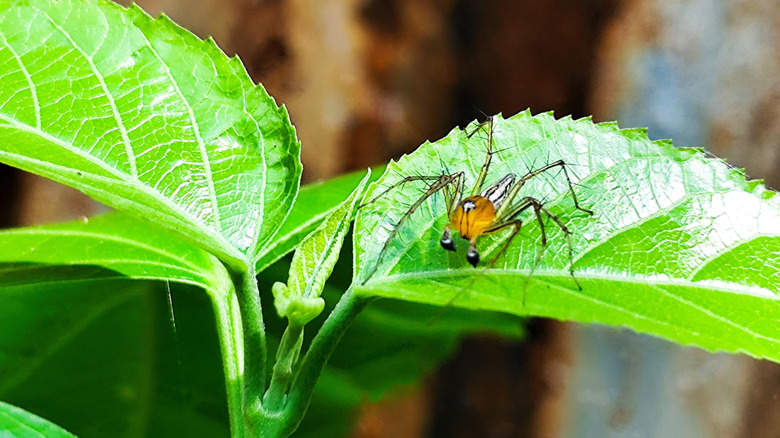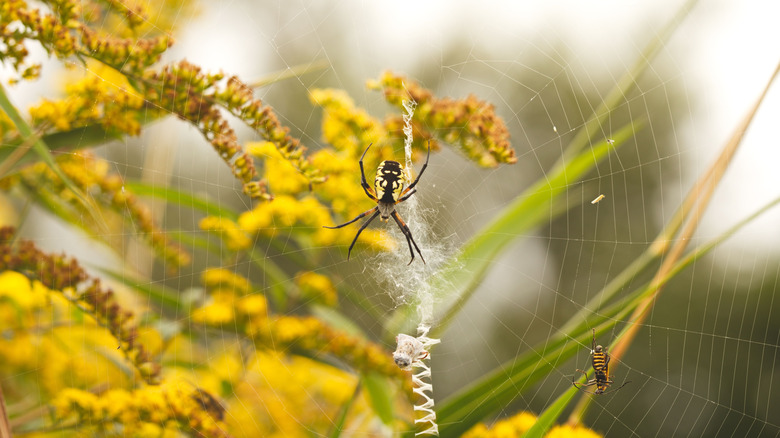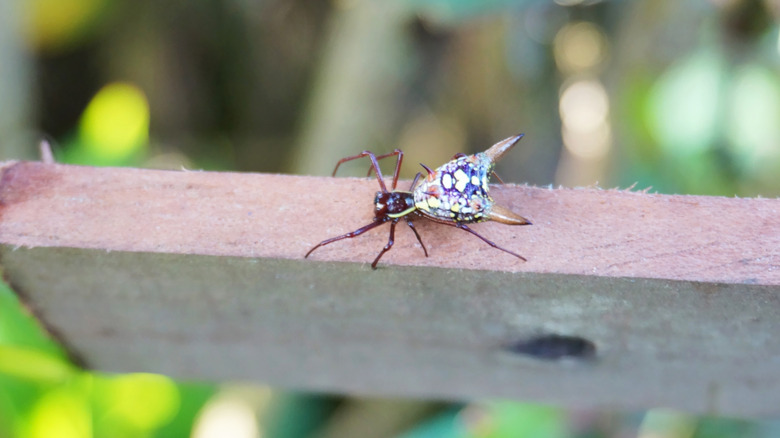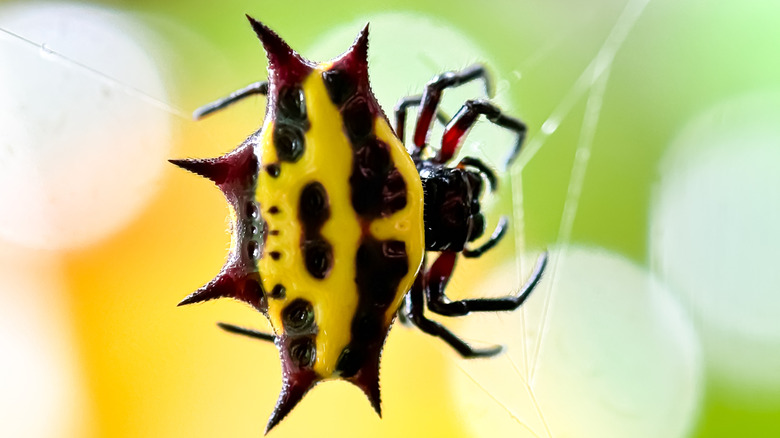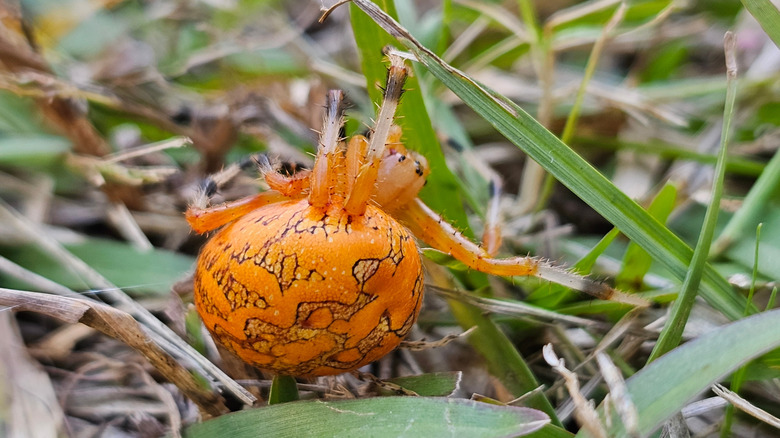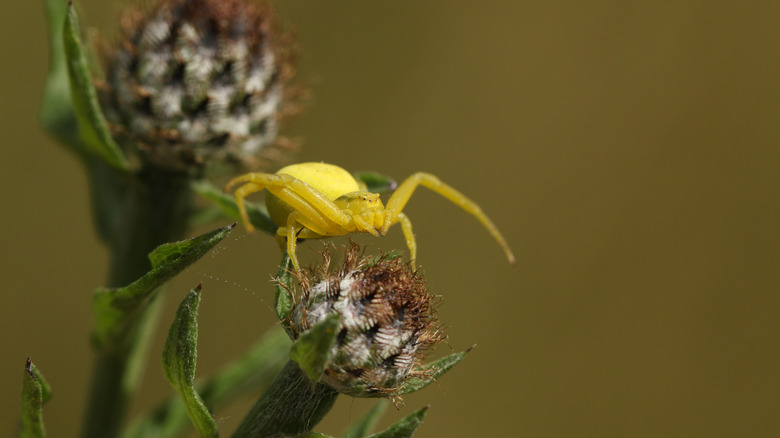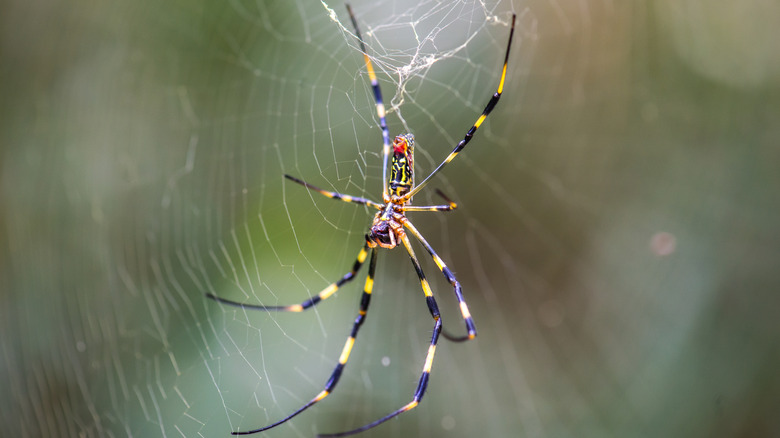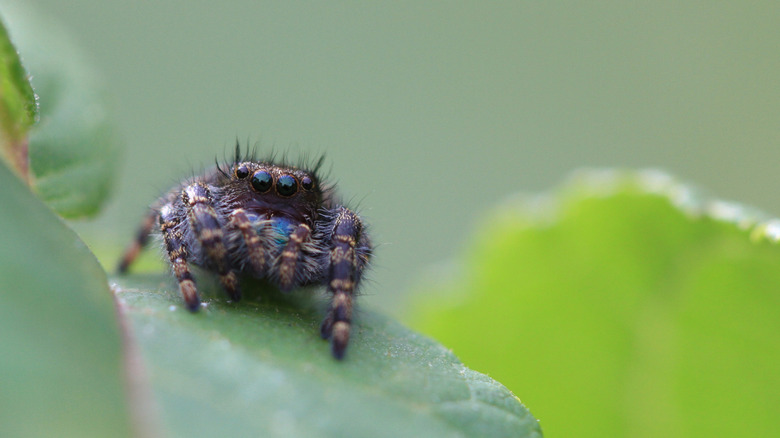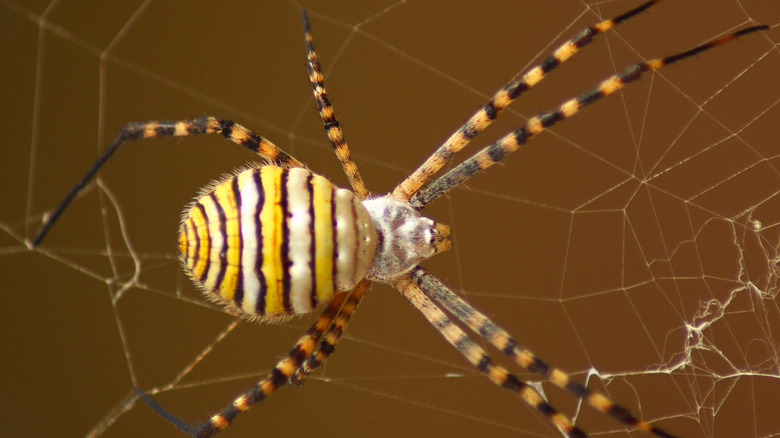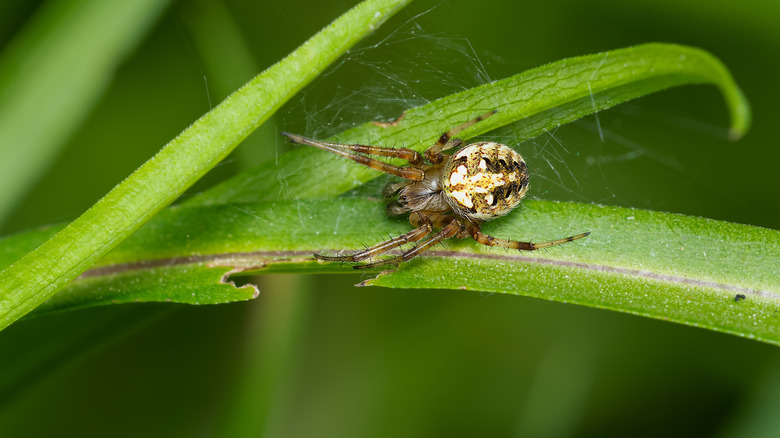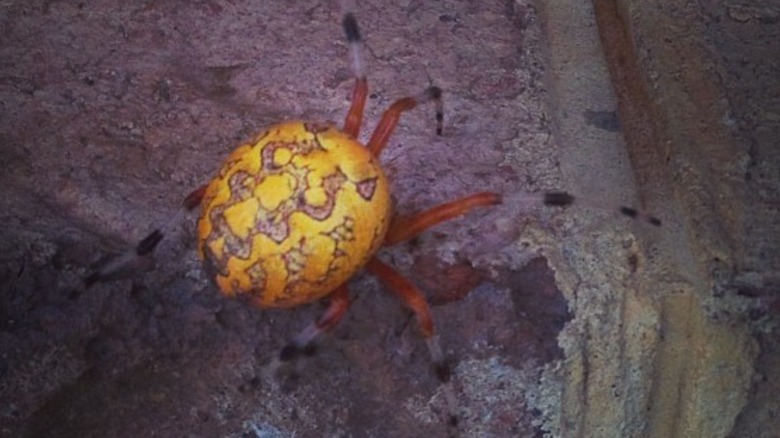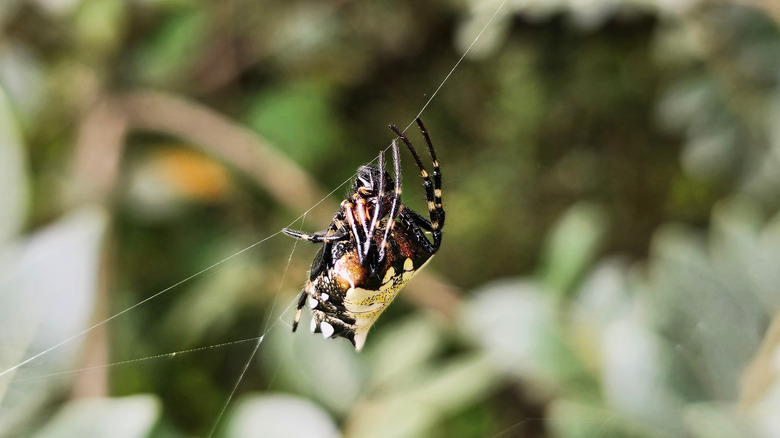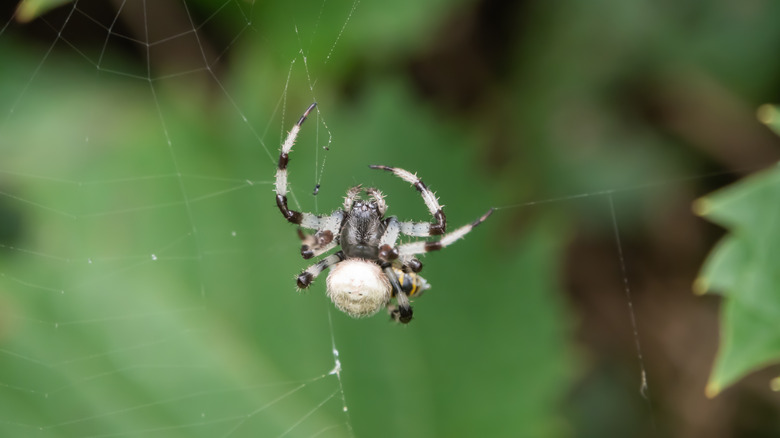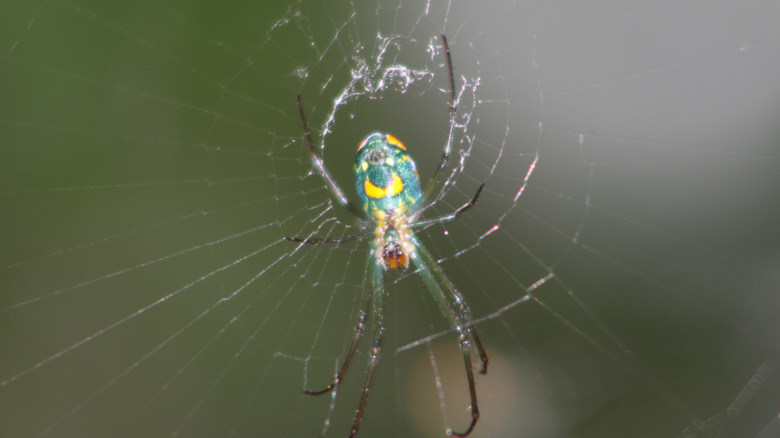Identifying Black And Yellow Spiders In Your Yard: Which Ones Are Poisonous?
Our yards and gardens are filled with life. But some of those living creatures are not what many people desire, like spiders. As creepy crawlers that honestly just look like they came straight out of a horror movie, some don't want these arthropods around, especially those with bright colors. Garden and bug enthusiasts know that most arachnids, like the vibrant black and yellow ones, get a bad rap; so before you try to kill or remove them, you need to know what you have and if they are actually potentially dangerous. Most black and yellow spiders in your yard are harmless, like yellow garden spiders or crab spiders.
Before you consider removing these arthropods, remember that they play a pivotal role in your garden and yard's ecosystem by keeping pests away. These eight-legged friends have a huge misconception looming over them thanks to some homeowners' concerns that they are poisonous and will cause immense pain. But luckily for you, spiders are not poisonous unless you ingest them, which could cause you to become violently ill. Instead, they are venomous, injecting their venom through a bite, which can cause discomfort, redness, itching, and pain similar to a wasp or bee sting. Since these beauties are beneficial in your yard, protect yourself by wearing gloves, long-sleeve clothes, and pants, tucking loose items into shoes and pants, covering all exposed skin. You can combine these barriers with insect repellent if you are particularly concerned about bites.
Yellow garden spider
There's no need to remove yellow garden spiders (Argiope aurantia) from your yard because they are a harmless arachnid to humans. They have venom that only affects their prey. These types of spiders spin circular webs in backyard sunny spots, usually around plants. Female web spinners have more pronounced yellow patches on their black abdomens. After mating, the males die. While some females can live years, most perish at the year's first frost. Their eggs stay dormant over winter and hatch during summer and fall. These arthropods keep many pests aways, including mosquitoes, gnats, and flies.
Arrow-shaped micrathena
As a unique-looking arachnid, arrow-shaped micrathena spiders (Micrathena sagittata) have red bodies with a large yellow abdomen that juts out with two black points. Gaining the fun nickname of the Pikachu spider, you can easily spot these females lounging in their circular webs. Their male counterparts are significantly smaller and will die after mating while females expire during the first frost. Expect their offspring to begin to emerge during the spring. While venomous to flying insects, these interesting orb weavers are harmless to humans.
Spiny-backed orb weaver
As an oddly-shaped spider, you may be alarmed when you first see a spiny-backed orb weaver (Gasteracantha cancriformis), but you don't need to be because this arachnid is not dangerous. It has six spikes that jut out from its abdomen with black legs. Its body can range in colors, including red, black, and yellow with black spots on top. Females are larger than the males and most only live until reproduction is complete. Eggs are left in a greenish ball of silk until they hatch, usually on the sides of houses, citrus trees, or shrubs.
Marbled orb weaver
Marbled orb weavers (Araneus marmoreus) rarely bite, but when they do, it's similar to a wasp sting. They have yellow-spotted orange abdomens that have brown or purple markings with reddish to dark brown legs. Preferring moist areas, especially in shrubs, tall grasses, and other wooded plants, they have a vertical web with a center marker, indicating when prey is stuck. Unlike many other spiders, this one waits in a leaf and silk retreat on the side of its web. Active mainly in late summer and fall, these arachnids catch flying pests in your yard.
Goldenrod crab spider
Luckily, goldenrod crab spiders (Misumena vatia) are beneficial pests that won't leave webs in your garden. Instead, these yellow arachnids wait in flowers to strike their next meal. Females are mainly yellow but sometimes have red lines while the male may have some yellow, reddish to brown legs, and markings. These pale beauties hang around in your garden from May to August, eating anything that whizzes by, including pests like flies and wasps. Unlike other spiders, they walk like a crab. While they do have venom to subdue their prey, it is not harmful to humans.
Joro spider
Don't be surprised when you see this giant creature more often because joro spiders (Trichonephila clavata) began spreading around the U.S. in the 2010s. Originally from Asia, they look large and scary, but are one of the shyest spiders around. With venom only strong enough to weaken prey, a bite most likely will not even pierce your skin. Females are visually striking with yellow abdomens that have blueish-green stripes and long black legs with yellow bands. Males have a brown abdomen with yellow bands. These arachnids create a strong, golden web that catches stink bugs and other pests.
Bold jumper
As a small spider that can jump far distances, bold jumpers (Phidippus audax) are common throughout North America. With one of the largest sets of eyes, it helps them quickly capture their prey. They have black bodies with patches of yellow, white, or orange on top. Their mouth parts, chelicerae, are iridescent green. You'll find these tiny arachnids during the day on window sills and decks. While they don't usually bite, you'll experience slight redness, itchiness, and discomfort for a day or two if they do. The female brings her egg silk sac into her web retreat until they hatch.
Banded garden spider
Banded garden spiders (Argiope trifasciata) are a black and yellow arthropod found throughout the United States. Females have an oval, pointed yellow abdomen with black stripes and long legs that have alternating yellow and black bands. Males look similar but smaller with a white abdomen. With kettledrum-looking egg sacs, their offspring hatch the following spring. Don't handle these sacs unless you want to get bitten. But even then, they produce venom that only yields a bite similar to a bee sting. Banded garden spiders build their webs where they can get optimal heat gain.
Arabesque orb weaver
With a name inspired by Arabic and Moorish patterns, arabesque orb weavers (Neoscona arabesca) have distinctive dark marks on their backs. Their body comes in a variety of shades of yellow, orange, tan, brown and black. Creating ornate, wheel-shaped webs, the female stays perched and hidden at night, waiting for her next meal. Common around homes in the country, they like to reside on barns and wood fences, keeping flies and moths away. While they are ferocious to their prey, they typically don't bite humans unless provoked. And even then, their bites are not harmful.
Lattice orb weaver
Lattice orb weavers (Araneus thaddeus) make large, detailed webs in your yard. This spider has a round yellow or orange abdomen that has markings on its back. Their legs range in colors from yellow to dark brown and are short and spiky. These arachnids help control the population of flying pests like flies and moths. Just like other orb weavers, they are venomous, but to humans, their bite is harmless. Since they prefer low places like your veggie garden or flower bed, don't be alarmed. Instead, let them do their job.
Arrowhead orb weaver
An interesting-looking spider that you may think is venomous is the arrowhead orb weaver (Verrucosa arenata). With a yellow abdomen shaped like an arrowhead, it is triangular and acicular. It may also have red markings. While it venom that paralyzes its prey, it will not harm you. A little bit different from the other orb weavers, it sits on its web with its head up and its legs tucked under its abdomen. While they prefer hiking trails, you can find them in a yard with enough shrubs and trees.
Shamrock orb weaver
While the shamrock orb weaver (Araneus trifolium) isn't necessarily green, it has a round abdomen that is yellow, white, red, and sometimes purple with white dots. The legs are light brown with black bands. Making a new web daily, it prefers to sit upside down in the center; however, they can expel a strand of web to hide out on some nearby leaves. Although these arachnids are harmless to humans, that doesn't mean you should pick one up. These spiders have very poor eyesight, so leaving them in an unfamiliar place can be dangerous for them.
Orchard orb weaver
Orchard orb weavers (Leucauge venusta) are the spiders behind the communal webs creeping across your home. As the only web spinner named by Charles Darwin, they are a visually striking arachnid with a black body and a blue and yellow abdomen. These spiders have long legs that are black and green. With their circular webs, they like to hang from the middle with their backs facing the ground. The female produces dark-orange eggs that she keeps safe in the egg sac. Luckily, they are not dangerous to humans, so you don't need to swat these arthropods away.
